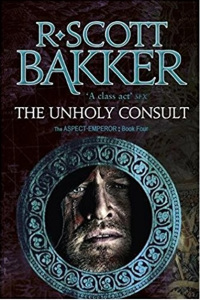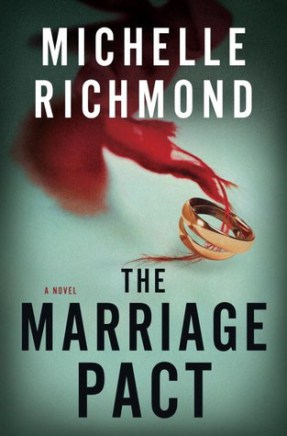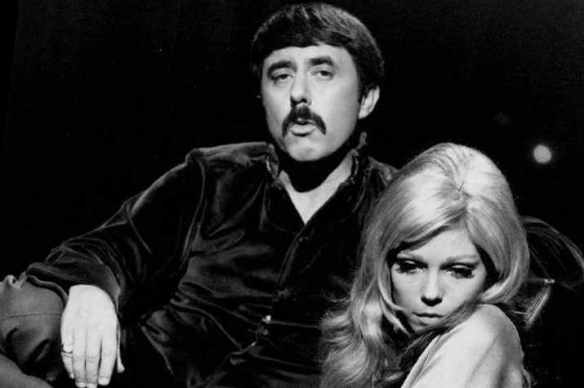
- Genre: epic fantasy
- Series: Aspect-Emperor, part 4
In reviewing this novel, I accidentally wrote a novel myself.
So it has come to this. The final book in the Aspect-Emperor sub-series. All storylines converge in the far north. The Ordeal marches on across Agongorea, while it succumbs ever more to the madness of the Sranc that are eaten. Akka and Mimara go north, in search of Kellhus to confront him with Mimara’s Judging Eye. Kellhus himself thwarted Yatwer, saved Esmenet and Kelmomas and brings them as he returns to the Ordeal. Sorweel, Serwa and Moenghus too return, after Ishterebinth has been cleansed of Consult influence.
Bakker drops many answers, or at least hints towards answers, to questions that have been open for many books. What exactly happened during the Circumfixion? Why did Kellhus break Proyas’ faith? And so on. He also leaves many things ambiguous, and the eventual manuscript is sure to generate long discussions on internet fora.
In my reviews of the previous books, The Judging Eye (2009), The White-Luck Warrior (2011) and The Great Ordeal (2016), I have mused about Bakker’s deeper goals and the themes that he is grappling with. Above all, it was clear to me that Bakker’s two series are a profound meditation upon the natures of love, worship, relationships and power, and how the Dunyain make travesties of these concepts. Still, I feel like there is a deeper thematic layer in Bakker’s work and that I have not fully taken up the gauntlet that he throws before his readers’ feet.
The most superficial way of looking at this story is that of a march of the armies of humanity against an evil force, in the way that Aragorn returned to Gondor in the Lord of the Rings and then marched all the good and righteous human men, filled with nobility, against the evil Sauron and his quest for power. A very black and white picture of good and evil. The Aspect-Emperor series is in many ways a color negative version of Tolkien’s story. A similar picture of good and evil exists, an objective morality that declares people damned or not, but it feels either justly or unjustly imposed by “gods” and does not align with the war between what we interpret as good and evil forces in the story. This is not a critique; this is by design.
The Aragorn of this story, Kellhus, may therefore liberate humanity from evil, while being damned in the eyes of the gods all the same. As we saw in The Judging Eye, Mimara has a metaphysical third eye that shows the truth about someone’s damnation in the afterlife. Achamian is damned simply because he is a sorcerer and messing with the nature of reality has damned him. But using other humans as tools is similarly damnable and if there is one thing that the Dunyain do, is making tools of humans. Don’t they deserve damnation for that? As Gandalf says to Frodo: who are we to decide what others deserve? Especially since Kellhus’ action of making a tool out of humanity might well save the human race. Now the nature of good and evil is totally twisted, and even the evil force bent upon eliminating humanity is given an ethically defensible position.
Phew. This raises so many questions. We have different definitions of good and evil now in the story that are juxtaposed, including everything that we take personally into the books with us. Different lenses of morality to flip before your eyes to look at the story. And Kellhus, the lynchpin, both sociopath and savior (depending on which lens of morality you use), carries on his shoulders the future of humanity and the wrath of the Gods and of humanity’s evil adversaries. He is not a character to identify with, and how to regard him is a central mystery of the story. As is his plan.
There is no fantasy series in existence where this subversion is so thoroughly and captivatingly explored.
Sorweel, Believer-King and at the same time instrument of the goddess Yatwer, also embodies this central conflict of moralities. He is stretched between these vectors in a very immediate way. The marching humans, too, are stretched upon the same spider web of crossing moralities. They lose all sense of nobility and humanity to be able to even reach Golgotterath, but this is a consequence of Kellhus’ plan in which the human army is just a tool. Bakker does not shy away from graphically describing every depravity in a series of chapters that feel overlong.
The writing can be cryptic at times. Its connection with common human emotions does not work so well, probably because the text often feels overwrought and misses a poetic fluidity. Especially the chapters concerning the Ordeal and its descend into obscenity are full of prose that is just excessive. But when the focus turns towards the landscapes or the large scales of time and space, the prose does have exactly the intended effect, and I can feel the sheer weight, the enormity of the events I am witnessing. This is epic to an awe-inspiring level, and the battle of Golgotterath holds its own compared to the battle of Minas Tirith. Almost no other current fantasy series reaches this height, and it is also a clear victory for Bakker’s world-building.
Bakker dives into inhuman states of mind with great gusto. Just about every character is filled to the brim with conflicting emotions and traumas, and if you thought you were going to read a simple story of a human army marching towards the bad guys, you thought wrong. This is not Tolkien. This is closer to the later parts of M. John Harrison’s Viriconium novels, in which alien madness infects humanity. But it is not just madness; there is a clear vision behind this series, and together with every step that the army takes, we step through Bakker’s design.
Without spoiling the ending, it will divide people. It’s abrupt and rather unsatisfying. In general, the pacing of the novel is uneven, with some parts stretched out in the first half and the ending feels a bit truncated. On the one hand, the sub-series definitely gets the ending it deserves. This is a 450-page ending, in which every twist and turn of the concluding events are writ large. The fortunes wax and wane in a gigantic concluding battle. The confluence of powers is on a level with Steven Erikson’s books. Originally it was supposed to form a single novel with the previous one, and it does feel like the book is not a self-standing whole, but I think Bakker made the right decision in cutting it in half. Abridging this story would have hurt its impact. On the other hand, the ending is also a setup for a next series and that may be why many characters do not get a fair conclusion of their arc in this novel. Too many questions remain, and some built-up antagonists feel underwhelming. Let us hope that future books will truly wrap it up for the characters.
Almost one-third of the novel is taken up by a gargantuan appendix that brings back memories of the novel of The Return of the King. It also has two short stories.
What do you get when you have an author who really “gets it” when it comes to worldbuilding, who creates unique and fascinating characters and has a deep philosophical interest behind writing his series? You get one of the best fantasy series ever written; it is surely in my top five of all time. Bakker’s series is on a level with Gene Wolfe’s The Book of the New Sun, and like Wolfe’s series it will probably never really find the big crowds of readers and will be disliked by some, but it will also be found again and again with each new generation and it will be greatly admired by a subset of readers.
9/10
Advertisements Share this:




